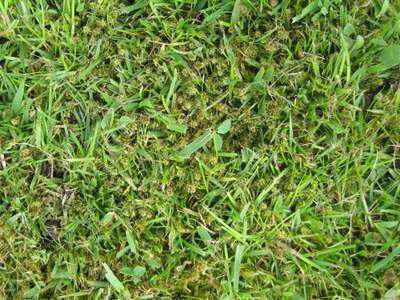Home › Lawn problems › Lawn moss prevention
Lawn Moss
Causes And Prevention
Lawn moss is a common problem for many gardeners. Left unchecked moss can rapidly spread throughout your lawn weakening and eventually replacing the grass.

It does this by effectively choking the lawn grasses and depriving them of the essential nutrients in the soil.
If you have a moss problem your first instinct may be to reach for the moss killer.
This may kill the moss in the short term but, unless you address the underlying problem of why the moss is growing in the first place, it will simply keep reappearing.
Moss killers have their place but you also need to look at the reasons why moss is growing in your lawn. Understanding the factors that encourage moss growth is the key to finding a long term solution.
Left unchecked a moss problem is only going to get worse over time so it is important to tackle it sooner rather than later.
Factors that can cause a lawn moss problem
Lawn moss thrives in moist, shady conditions and most mosses prefer acidic soil so your lawn will be predisposed to moss growth if...
- ... you live in a wet climate
- ... you have acid soil
- ... or a shady garden
But this isn't the whole story because mosses are also opportunistic colonizers and poor growing conditions that inhibit the growth of lawn grasses will also favour the appearance of moss and allow it to take a hold. Typically these include...
- ... waterlogging due to poorly drained soil
- ... periods of drought
- ... an impoverished lawn due to inadequate feeding
- ... compacted soil
- ... worn turf in high traffic areas
- ... mowing too close and scalping the lawn
- ... excessive lawn thatch
As you can see, some of the factors involved are environmental and hard to eliminate but many are down to the way you maintain your lawn and good lawn care practices are a key weapon in your fight against lawn moss.
Solving your lawn moss problem. Step 1: Control the moss
Start by removing the moss either manually, by scarifying your lawn, or using a proprietory moss killer.
Moss killers usually contain iron sulphate and the best time to apply them is in spring or early autumn. Follow the instructions on the pack and apply at the recommended rate.
If your lawn looks impoverished you can use a mosskiller combined with a fertilizer. These will not only kill the moss but will give your grass a boost at the same time.
After two to three weeks the moss will blacken and die and can be raked out.
Solving your lawn moss problem. Step 2: Address the underlying causes
Wet climate
You can't change the climate but you can try overseeding your lawn with grasses that are more able to cope with wet conditions.
Acid soil
If you think you have acid soil, carry out a soil pH test. It's cheap and easy and worth the trouble. If the pH is below 6.5 buy some garden lime (ground limestone) and apply it according to the instructions on the pack. This will raise the pH and deter moss.
Shady gardens
Most lawn grasses don't grow well in shade. If your lawn is shaded by overhanging trees try to alleviate the problem by removing the lower branches and thinning the canopy. This should let more light in.
You can also try overseeding with a grass mix specifically designed to be shade tolerant.
Waterlogging due to poorly drained soil
Lawn grasses hate waterlogged, usually clay, soil, and will soon become stressed and weak. You have a number of options if you garden on heavy soil.
If the clay content is very high your lawn is going to struggle and you may have to take drastic action. You could strip off the existing turf and rotovate a free draining soil mix into the clay or you could install a drainage system. Both are serious measures and you may well think that an easier solution might be to look at lawn alternatives.
If the problem is less severe try aerating with a hollow tiner and then topdressing. This will open up the soil and improve drainage.
Periods of drought
Lawn grasses are capable of surviving periods of drought but if the periods are extended and you continue to use your lawn in the normal way, the grass will be weakened and may even die.
Prevent lawn moss gaining a foothold by overseeding your lawn in the fall when conditions are cooler and damper.
Impoverished lawn due to inadequate feeding
If your grass looks sickly and weak and is a yellowish green colour it is probably short of essential nutrients. Hungry grass is in no condition to hold its own against a moss attack.
Rectify the problem by feeding at least twice a year in spring and autumn using a fertilizer formulated for the specific season.
Compacted soil
This is a common problem in over used areas of the lawn such as walkways and play areas. Lawn grasses hate compacted soil so aerate high-use areas regularly.
For frequently used routes across your lawn sink some flagstones into the surface to create a walkway.
Worn turf in high traffic areas
This is usually combined with the problem of compaction described above. Moss will soon start to grow on bald patches of lawn so reseed these areas as necessary.
Mowing too close and 'scalping' the lawn
Grass suffers if it is regularly cut too short and may be killed altogether by scalping. Take the trouble to raise or lower your mower blades according to the season and the length of grass.
A good rule of thumb is to never remove more than a third of the height of the grass.
Excessive lawn thatch
If your lawn has more than about half an inch of thatch the grass will suffer and the moss will thrive. The information about lawn thatch will help you remedy the situation.
For more information visit these related Lawn and Lawn Care pages
There is more information about other common lawn problems at common lawn problems.
Many lawn problems can be prevented by good lawn maintenance practices. Find out more at Lawn Maintenance: How to Keep your Lawn in Great Condition.
Home › Lawn problems › Lawn moss prevention
